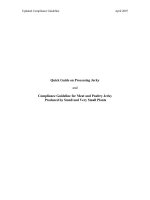csharp quick guide
Bạn đang xem bản rút gọn của tài liệu. Xem và tải ngay bản đầy đủ của tài liệu tại đây (323.28 KB, 71 trang )
/>Copyright © tutorialspoint.com
C# - QUICK GUIDE
C# - OVERVIEW
C# is a modern, general-purpose object oriented programming language developed by Microsoft and approved by Ecma
and ISO.
C# was developed by Anders Hejlsberg and his team during the development of .Net Framework.
C# is designed for Common Language Infrastructure (CLI), which consists of the executable code and runtime
environment that allows use of various high-level languages to be used on different computer platforms and
architectures.
The following reasons make C# a widely used professional language:
Modern, general purpose programming language
Object oriented.
Component oriented.
Easy to learn.
Structured language.
It produces efficient programs.
It can be compiled on a variety of computer platforms.
Part of .Net Framework.
Strong Programming Features of C#
Although C# constructs closely follows traditional high level languages C and C++ and being an object oriented
programming language, it has strong resemblance with Java, it has numerous strong programming features that make it
endearing to multitude of programmers worldwide.
Following is the list of few important features:
Boolean Conditions
Automatic Garbage Collection
Standard Library
Assembly Versioning
Properties and Events
Delegates and Events Management
Easy to use Generics
Indexers
Conditional Compilation
Simple Multithreading
LINQ and Lambda Expressions
Integration with Windows
C# - ENVIRONMENT
Integrated Development Environment (IDE) For C#
Microsoft provides the following development tools for C# programming:
Visual Studio 2010 (VS)
Visual C# 2010 Express (VCE)
Visual Web Developer
The last two are freely available from Microsoft official website. Using these tools you can write all kinds of C#
programs from simple command-line applications to more complex applications. You can also write C# source code
files using a basic text editor, like Notepad, and compile the code into assemblies using the command-line compiler,
which is again a part of the .NET Framework.
Visual C# Express and Visual Web Developer Express edition are trimmed down versions of Visual Studio and has the
same look and feel. They retain most features of Visual Studio. In this tutorial, we have used Visual C # 2010 Express.
You can download it from Microsoft Visual Studio. It gets automatically installed in your machine. Please note that you
need an active internet connection for installing the express edition.
Writing C# Programs on Linux or Mac OS
Although the.NET Framework runs on the Windows operating system, there are some alternative versions that work on
other operating systems. Mono is an open-source version of the .NET Framework, which includes a C# compiler and
runs on several operating systems, including various flavors of Linux and Mac OS. Kindly check Go Mono.
The stated purpose of Mono is not only to be able to run Microsoft .NET applications cross-platform, but also to bring
better development tools to Linux developers. Mono can be run on many operating systems including Android, BSD,
iOS, Linux, OS X, Windows, Solaris and UNIX.
C# - PROGRAM STRUCTURE
C# Hello World Example
A C# program basically consists of the following parts:
Namespace declaration
A class
Class methods
Class attributes
A Main method
Statements & Expressions
Comments
Let us look at a simple code that would print the words "Hello World":
using System;
namespace HelloWorldApplication
{
class HelloWorld
{
static void Main(string[] args)
{
/* my first program in C# */
Console.WriteLine("Hello World");
Console.ReadKey();
}
}
}
When the above code is compiled and executed, it produces following result:
Hello World
Let us look at various parts of the above program:
The first line of the program using System; - the using keyword is used to include the System namespace in the
program. A program generally has multiple using statements.
The next line has the namespace declaration. A namespace is a collection of classes. The
HelloWorldApplication namespace contains the class HelloWorld.
The next line has a class declaration, the class HelloWorld, contains the data and method definitions that your
program uses. Classes generally would contain more than one method. Methods define the behavior of the class.
However, the HelloWorld class has only one method Main.
The next line defines the Main method, which is the entry point for all C# programs. The Main method states
what the class will do when executed
The next line /* */ will be ignored by the compiler and it has been put to add additional comments in the
program.
The Main method specifies its behavior with the statement Console.WriteLine("Hello World");
WriteLine is a method of the Console class defined in the System namespace. This statement causes the message
"Hello, World!" to be displayed on the screen.
The last line Console.ReadKey(); is for the VS.NET Users. This makes the program wait for a key press and it
prevents the screen from running and closing quickly when the program is launched from Visual Studio .NET.
Its worth to note the following points:
C# is case sensitive.
All statements and expression must end with a semicolon (;).
The program execution starts at the Main method.
Unlike Java, file name could be different from the class name.
Compile & Execute a C# Program:
If you are using Visual Studio.Net for compiling and executing C# programs, take the following steps:
Start Visual Studio.
On the menu bar, choose File, New, Project.
Choose Visual C# from templates, and then choose Windows.
Choose Console Application.
Specify a name for your project, and then choose the OK button.
The new project appears in Solution Explorer.
Write code in the Code Editor.
Click the Run button or the F5 key to run the project. A Command Prompt window appears that contains the line
Hello World.
You can compile a C# program by using the command line instead of the Visual Studio IDE:
Open a text editor and add the above mentioned code.
Save the file as helloworld.cs
Open the command prompt tool and go to the directory where you saved the file.
Type csc helloworld.cs and press enter to compile your code.
If there are no errors in your code the command prompt will take you to the next line and would generate
helloworld.exe executable file.
Next, type helloworld to execute your program.
You will be able to see "Hello World" printed on the screen.
C# - BASIC SYNTAX
C# is an object oriented programming language. In Object Oriented Programming methodology a program consists of
various objects that interact with each other by means of actions. The actions that an object may take are called methods.
Objects of the same kind are said to have the same type or, more often, are said to be in the same class.
For example, let us consider a Rectangle object. It has attributes like length and width. Depending upon the design, it
may need ways for accepting the values of these attributes, calculating area and display details.
Let us look at an implementation of a Rectangle class and discuss C# basic syntax, on the basis of our observations in it:
using System;
namespace RectangleApplication
{
class Rectangle
{
// member variables
double length;
double width;
public void Acceptdetails()
{
length = 4.5;
width = 3.5;
}
public double GetArea()
{
return length * width;
}
public void Display()
{
Console.WriteLine("Length: {0}", length);
Console.WriteLine("Width: {0}", width);
Console.WriteLine("Area: {0}", GetArea());
}
}
class ExecuteRectangle
{
static void Main(string[] args)
{
Rectangle r = new Rectangle();
r.Acceptdetails();
r.Display();
Console.ReadLine();
}
}
}
When the above code is compiled and executed, it produces following result:
Length: 4.5
Width: 3.5
Area: 15.75
The using Keyword
The first statement in any C# program is
using System;
The using keyword is used for including the namespaces in the program. A program can include multiple using
statements.
The class Keyword
The class keyword is used for declaring a class.
Comments in C#
Comments are used for explaining code. Compilers ignore the comment entries. The multiline comments in C#
programs start with /* and terminates with the characters */ as shown below:
/* This program demonstrates
The basic syntax of C# programming
Language */
Single line comments are indicated by the '//' symbol. For example,
}//end class Rectangle
Member Variables
Variables are attributes or data members of a class, used for storing data. In the preceding program, the Rectangle class
has two member variables named length and width.
Member Functions
Functions are set of statements that perform a specific task. The member functions of a class are declared within the
class. Our sample class Rectangle contains three member functions: AcceptDetails, GetArea and Display.
Instantiating a Class
In the preceding program, the class ExecuteRectangle is used as a class which contains the Main() method and
instantiates the Rectangle class.
Identifiers
An identifier is a name used to identify a class, variable, function, or any other user-defined item. The basic rules for
naming classes in C# are as follows:
A name must begin with a letter that could be followed by a sequence of letters, digits (0 - 9) or underscore. The
first character in an identifier cannot be a digit.
It must not contain any embedded space or symbol like ? - +! @ # % ^ & * ( ) [ ] { } . ; : " ' / and \. However an
underscore ( _ ) can be used.
It should not be a C# keyword.
C# - DATA TYPES
In C#, variables are categorized into the following types:
Value types
Reference types
Pointer types
Value Types
The following table lists the available value types in C# 2010:
Type Represents Range Default
Value
bool Boolean value True or False False
byte 8-bit unsigned integer 0 to 255 0
char 16-bit Unicode character U +0000 to U +ffff '\0'
decimal 128-bit precise decimal values with
28-29 significant digits
(-7.9 x 10
28
to 7.9 x 10
28
) / 10
0 to 28
0.0M
double 64-bit double-precision floating point
type
(+/-)5.0 x 10
-324
to (+/-)1.7 x 10
308
0.0D
float 32-bit single-precision floating point
type
-3.4 x 10
38
to + 3.4 x 10
38
0.0F
int 32-bit signed integer type -2,147,483,648 to 2,147,483,647 0
long 64-bit signed integer type -923,372,036,854,775,808 to
9,223,372,036,854,775,807
0L
sbyte 8-bit signed integer type -128 to 127 0
short 16-bit signed integer type -32,768 to 32,767 0
uint 32-bit signed integer type 0 to 4,294,967,295 0
ulong 64-bit signed integer type 0 to 18,446,744,073,709,551,615 0
ushort 16-bit signed integer type 0 to 65,535 0
Reference Types
The reference types do not contain the actual data stored in a variable, but they contain a reference to the variables.
In other words, they refer to a memory location. Using more than one variable, the reference types can refer to a
memory location. If the data in the memory location is changed by one of the variables, the other variable automatically
reflects this change in value. Example of built in reference types are: object, dynamic and string.
Object Type
The Object Type is the ultimate base class for all data types in C# Common Type System(CTS). Object is an alias for
System.Object class. So object types can be assigned values of any other types, value types, reference types, predefined
or user-defined types. However, before assigning values, it needs type conversion.
When a value type is converted to object type, it is called boxing and on the other hand, when an object type is
converted to a value type it is called unboxing.
object obj;
obj = 100; // this is boxing
Dynamic Type
You can store any type of value in the dynamic data type variable. Type checking for these types of variables takes
place at runtime.
Syntax for declaring a dynamic type is:
dynamic <variable_name> = value;
For example,
dynamic d = 20;
Dynamic types are similar to object types except that, type checking for object type variables takes place at compile
time, whereas that for the dynamic type variables take place at run time.
String Type
The String Type allows you to assign any string values to a variable. The string type is an alias for the System.String
class. It is derived from object type. The value for a string type can be assigned using string literals in two forms:
quoted and @quoted.
For example,
String str = "Tutorials Point";
A @quoted string literal looks like:
@"Tutorials Point";
The user defined reference types are: class, interface, or delegate. We will discuss these types in later chapter.
Pointer Types
Pointer type variables store the memory address of another type. Pointers in C# have the same capabilities as in C or
C++.
Syntax for declaring a pointer type is:
type* identifier;
For example,
char* cptr;
int* iptr;
C# - TYPE CONVERSION
Type conversion is basically type casting, or converting one type of data to another type. In C#, type casting has two
forms:
Implicit type conversion - these conversions are performed by C# in a type-safe manner. Examples are
conversions from smaller to larger integral types, and conversions from derived classes to base classes.
Explicit type conversion - these conversions are done explicitly by users using the pre-defined functions.
Explicit conversions require a cast operator.
C# Type Conversion Methods
C# provides the following built-in type conversion methods:
S.N Methods & Description
1
ToBoolean
Converts a type to a Boolean value, where possible.
2
ToByte
Converts a type to a byte.
3
ToChar
Converts a type to a single Unicode character, where possible.
4
ToDateTime
Converts a type (integer or string type) to date-time structures.
5
ToDecimal
Converts a floating point or integer type to a decimal type.
6
ToDouble
Converts a type to a double type.
7
ToInt16
Converts a type to a 16-bit integer.
8
ToInt32
Converts a type to a 32-bit integer.
9
ToInt64
Converts a type to a 64-bit integer.
10
ToSbyte
Converts a type to a signed byte type.
11
ToSingle
Converts a type to a small floating point number.
12
ToString
Converts a type to a string.
13
ToType
Converts a type to a specified type.
14
ToUInt16
Converts a type to an unsigned int type.
15
ToUInt32
Converts a type to an unsigned long type.
16
ToUInt64
Converts a type to an unsigned big integer.
The following example converts various value types to string type:
namespace TypeConversionApplication
{
class StringConversion
{
static void Main(string[] args)
{
int i = 75;
float f = 53.005f;
double d = 2345.7652;
bool b = true;
Console.WriteLine(i.ToString());
Console.WriteLine(f.ToString());
Console.WriteLine(d.ToString());
Console.WriteLine(b.ToString());
Console.ReadKey();
}
}
}
When the above code is compiled and executed, it produces following result:
75
53.005
2345.7652
True
C# - VARIABLES
A variable is nothing but a name given to a storage area that our programs can manipulate. Each variable in C# has a
specific type, which determines the size and layout of the variable's memory; the range of values that can be stored
within that memory; and the set of operations that can be applied to the variable.
We have already discussed various data types. The basic value types provided in C# can be categorized as:
Type Example
Integral types sbyte, byte, short, ushort, int, uint, long, ulong and char
Floating point types float and double
Decimal types decimal
Boolean types true or false values, as assigned
Nullable types Nullable data types
C# also allows defining other value types of variable like enum and reference types of variables like class, which we
will cover in subsequent chapters. For this chapter, let us study only basic variable types.
Variable Declaration in C#
Syntax for variable declaration in C# is:
<data_type> <variable_list>;
Here, data_type must be a valid C# data type including char, int, float, double, or any user defined data type etc., and
variable_list may consist of one or more identifier names separated by commas.
Some valid variable declarations along with their definition are shown here:
int i, j, k;
char c, ch;
float f, salary;
double d;
You can initialize a variable at the time of declaration as:
int i = 100;
Variable Initialization in C#
Variables are initialized (assigned a value) with an equal sign followed by a constant expression. The general form of
initialization is:
variable_name = value;
Variables can be initialized (assigned an initial value) in their declaration. The initializer consists of an equal sign
followed by a constant expression as:
<data_type> <variable_name> = value;
Some examples are:
int d = 3, f = 5; /* initializing d and f. */
byte z = 22; /* initializes z. */
double pi = 3.14159; /* declares an approximation of pi. */
char x = 'x'; /* the variable x has the value 'x'. */
Lvalues and Rvalues in C#:
There are two kinds of expressions in C#:
1. lvalue : An expression that is an lvalue may appear as either the left-hand or right-hand side of an assignment.
2. rvalue : An expression that is an rvalue may appear on the right- but not left-hand side of an assignment.
Variables are lvalues and so may appear on the left-hand side of an assignment. Numeric literals are rvalues and so may
not be assigned and can not appear on the left-hand side. Following is a valid statement:
int g = 20;
But following is not a valid statement and would generate compile-time error:
10 = 20;
C# - CONSTANTS AND LITERALS
The constants refer to fixed values that the program may not alter during its execution. These fixed values are also
called literals. Constants can be of any of the basic data types like an integer constant, a floating constant, a character
constant, or a string literal. There are also enumeration constants as well.
The constants are treated just like regular variables except that their values cannot be modified after their definition.
Integer Literals
An integer literal can be a decimal, octal, or hexadecimal constant. A prefix specifies the base or radix: 0x or 0X for
hexadecimal, 0 for octal, and nothing for
An integer literal can also have a suffix that is a combination of U and L, for unsigned and long, respectively. The
suffix can be uppercase or lowercase and can be in any order.
Here are some examples of integer literals:
212 /* Legal */
215u /* Legal */
0xFeeL /* Legal */
078 /* Illegal: 8 is not an octal digit */
032UU /* Illegal: cannot repeat a suffix */
Following are other examples of various types of Integer literals:
85 /* decimal */
0213 /* octal */
0x4b /* hexadecimal */
30 /* int */
30u /* unsigned int */
30l /* long */
30ul /* unsigned long */
Floating-point Literals
A floating-point literal has an integer part, a decimal point, a fractional part, and an exponent part. You can represent
floating point literals either in decimal form or exponential form.
Here are some examples of floating-point literals:
3.14159 /* Legal */
314159E-5L /* Legal */
510E /* Illegal: incomplete exponent */
210f /* Illegal: no decimal or exponent */
.e55 /* Illegal: missing integer or fraction */
While representing using decimal form, you must include the decimal point, the exponent, or both and while
representing using exponential form you must include the integer part, the fractional part, or both. The signed exponent
is introduced by e or E.
Character Constants
Character literals are enclosed in single quotes e.g., 'x' and can be stored in a simple variable of char type. A character
literal can be a plain character (e.g., 'x'), an escape sequence (e.g., '\t'), or a universal character (e.g., '\u02C0').
There are certain characters in C# when they are proceeded by a back slash they will have special meaning and they are
used to represent like newline (\n) or tab (\t). Here you have a list of some of such escape sequence codes:
Escape sequence Meaning
\\ \ character
\' ' character
\" " character
\? ? character
\a Alert or bell
\b Backspace
\f Form feed
\n Newline
\r Carriage return
\t Horizontal tab
\v Vertical tab
\ooo Octal number of one to three digits
\xhh . . . Hexadecimal number of one or more digits
String Literals
String literals or constants are enclosed in double quotes "" or with @"". A string contains characters that are similar to
character literals: plain characters, escape sequences, and universal characters.
You can break a long line into multiple lines using string literals and separating the parts using whitespaces.
Here are some examples of string literals. All the three forms are identical strings.
"hello, dear"
"hello, \
dear"
"hello, " "d" "ear"
@"hello dear"
Defining Constants
Constants are defined using the const keyword. Syntax for defining a constant is:
const <data_type> <constant_name> = value;
C# - OPERATORS
An operator is a symbol that tells the compiler to perform specific mathematical or logical manipulations. C# is rich in
built-in operators and provides the following type of operators:
Arithmetic Operators
Relational Operators
Logical Operators
Bitwise Operators
Assignment Operators
Misc Operators
This tutorial will explain the arithmetic, relational, and logical, bitwise, assignment and other operators one by one.
Arithmetic Operators
Following table shows all the arithmetic operators supported by C#. Assume variable A holds 10 and variable B holds
20 then:
Show Examples
Operator Description Example
+ Adds two operands A + B will give 30
- Subtracts second operand from the first A - B will give -10
* Multiply both operands A * B will give 200
/ Divide numerator by de-numerator B / A will give 2
% Modulus Operator and remainder of after an integer division B % A will give 0
++ Increment operator increases integer value by one A++ will give 11
Decrement operator decreases integer value by one A will give 9
Relational Operators
Following table shows all the relational operators supported by C#. Assume variable A holds 10 and variable B holds 20
then:
Show Examples
Operator Description Example
== Checks if the value of two operands is equal or not, if yes then
condition becomes true.
(A == B) is not true.
!= Checks if the value of two operands is equal or not, if values
are not equal then condition becomes true.
(A != B) is true.
> Checks if the value of left operand is greater than the value of
right operand, if yes then condition becomes true.
(A > B) is not true.
< Checks if the value of left operand is less than the value of
right operand, if yes then condition becomes true.
(A < B) is true.
>= Checks if the value of left operand is greater than or equal to
the value of right operand, if yes then condition becomes true.
(A >= B) is not true.
<= Checks if the value of left operand is less than or equal to the
value of right operand, if yes then condition becomes true.
(A <= B) is true.
Logical Operators
Following table shows all the logical operators supported by C#. Assume variable A holds Boolean value true and
variable B holds Boolean value false then:
Show Examples
Operator Description Example
&& Called Logical AND operator. If both the operands are non
zero then condition becomes true.
(A && B) is false.
|| Called Logical OR Operator. If any of the two operands is non
zero then condition becomes true.
(A || B) is true.
! Called Logical NOT Operator. Use to reverses the logical state
of its operand. If a condition is true then Logical NOT
operator will make false.
!(A && B) is true.
Bitwise Operators
Show Examples
Operator Description Example
& Binary AND Operator copies a bit to the result if it exists in
both operands.
(A & B) will give 12 which is 0000
1100
| Binary OR Operator copies a bit if it exists in either operand. (A | B) will give 61 which is 0011
1101
^ Binary XOR Operator copies the bit if it is set in one operand
but not both.
(A ^ B) will give 49 which is 0011
0001
~ Binary Ones Complement Operator is unary and has the effect
of 'flipping' bits.
(~A ) will give -60 which is 1100
0011
<< Binary Left Shift Operator. The left operands value is moved
left by the number of bits specified by the right operand.
A << 2 will give 240 which is 1111
0000
>> Binary Right Shift Operator. The left operands value is moved
right by the number of bits specified by the right operand.
A >> 2 will give 15 which is 0000
1111
Assignment Operators
There are following assignment operators supported by C#:
Show Examples
Operator Description Example
= Simple assignment operator, Assigns values from right side
operands to left side operand
C = A + B will assign value of A + B
into C
+= Add AND assignment operator, It adds right operand to the
left operand and assign the result to left operand
C += A is equivalent to C = C + A
-= Subtract AND assignment operator, It subtracts right operand
from the left operand and assign the result to left operand
C -= A is equivalent to C = C - A
*= Multiply AND assignment operator, It multiplies right operand
with the left operand and assign the result to left operand
C *= A is equivalent to C = C * A
/= Divide AND assignment operator, It divides left operand with
the right operand and assign the result to left operand
C /= A is equivalent to C = C / A
%= Modulus AND assignment operator, It takes modulus using
two operands and assign the result to left operand
C %= A is equivalent to C = C % A
<<= Left shift AND assignment operator C <<= 2 is same as C = C << 2
>>= Right shift AND assignment operator C >>= 2 is same as C = C >> 2
&= Bitwise AND assignment operator C &= 2 is same as C = C & 2
^= bitwise exclusive OR and assignment operator C ^= 2 is same as C = C ^ 2
|= bitwise inclusive OR and assignment operator C |= 2 is same as C = C | 2
Misc Operators
There are few other important operators including sizeof, typeof and ? : supported by C#.
Show Examples
Operator Description Example
sizeof() Returns the size of a data type. sizeof(int), will return 4.
typeof() Returns the type of a class. typeof(StreamReader);
& Returns the address of an variable. &a; will give actual address of the
variable.
* Pointer to a variable. *a; will pointer to a variable.
? : Conditional Expression If Condition is true ? Then value X :
Otherwise value Y
is Determines whether an object is of a certain type. If( Ford is Car) // checks if Ford is an
object of the Car class.
as Cast without raising an exception if the cast fails. Object obj = new
StringReader("Hello");
StringReader r = obj as StringReader;
Operators Precedence in C#
Operator precedence determines the grouping of terms in an expression. This affects how an expression is evaluated.
Certain operators have higher precedence than others; for example, the multiplication operator has higher precedence
than the addition operator:
For example x = 7 + 3 * 2; Here x is assigned 13, not 20 because operator * has higher precedence than + so it first get
multiplied with 3*2 and then adds into 7.
Here operators with the highest precedence appear at the top of the table, those with the lowest appear at the bottom.
Within an expression, higher precedence operators will be evaluated first.
Show Examples
Category Operator Associativity
Postfix () [] -> . ++ - - Left to right
Unary + - ! ~ ++ - - (type)* & sizeof Right to left
Multiplicative * / % Left to right
Additive + - Left to right
Shift << >> Left to right
Relational < <= > >= Left to right
Equality == != Left to right
Bitwise AND & Left to right
Bitwise XOR ^ Left to right
Bitwise OR | Left to right
Logical AND && Left to right
Logical OR || Left to right
Conditional ?: Right to left
Assignment = += -= *= /= %=>>= <<= &= ^= |= Right to left
Comma , Left to right
C# - DECISION MAKING
Decision making structures require that the programmer specify one or more conditions to be evaluated or tested by the
program, along with a statement or statements to be executed if the condition is determined to be true, and optionally,
other statements to be executed if the condition is determined to be false.
Following is the general from of a typical decision making structure found in most of the programming languages:
C# provides following types of decision making statements. Click the following links to check their detail.
Statement Description
if statement
An if statement consists of a boolean expression followed by one or more
statements.
if else statement
An if statement can be followed by an optional else statement, which
executes when the boolean expression is false.
nested if statements
You can use one if or else if statement inside another if or else if
statement(s).
switch statement
A switch statement allows a variable to be tested for equality against a list
of values.
nested switch statements
You can use one swicth statement inside another switch statement(s).
C# - LOOPS
There may be a situation when you need to execute a block of code several number of times. In general statements are
executed sequentially: The first statement in a function is executed first, followed by the second, and so on.
Programming languages provide various control structures that allow for more complicated execution paths.
A loop statement allows us to execute a statement or group of statements multiple times and following is the general
from of a loop statement in most of the programming languages:
C# provides following types of loop to handle looping requirements. Click the following links to check their detail.
Loop Type Description
while loop Repeats a statement or group of statements until a given condition is true. It tests
the condition before executing the loop body.
for loop Execute a sequence of statements multiple times and abbreviates the code that
manages the loop variable.
do while loop Like a while statement, except that it tests the condition at the end of the loop
body
nested loops You can use one or more loop inside any another while, for or do while loop.
Loop Control Statements:
Loop control statements change execution from its normal sequence. When execution leaves a scope, all automatic
objects that were created in that scope are destroyed.
C# provides the following control statements. Click the following links to check their detail.
Control Statement Description
break statement
Terminates the loop or switch statement and transfers execution to the statement
immediately following the loop or switch.
continue statement Causes the loop to skip the remainder of its body and immediately retest its
condition prior to reiterating.
C# - ENCAPSULATION
Encapsulation is defined 'as the process of enclosing one or more items within a physical or logical package'.
Encapsulation, in object oriented programming methodology, prevents access to implementation details.
Abstraction and encapsulation are related features in object oriented programming. Abstraction allows making relevant
information visible and encapsulation enables a programmer to implement the desired level of abstraction .
Encapsulation is implemented by using access specifiers. An access specifier defines the scope and visibility of a class
member. C# supports the following access specifiers:
Public
Private
Protected
Internal
Protected internal
Public Access Specifier
Public access specifier allows a class to expose its member variables and member functions to other functions and
objects. Any public member can be accessed from outside the class.
The following example illustrates this:
using System;
namespace RectangleApplication
{
class Rectangle
{
//member variables
public double length;
public double width;
public double GetArea()
{
return length * width;
}
public void Display()
{
Console.WriteLine("Length: {0}", length);
Console.WriteLine("Width: {0}", width);
Console.WriteLine("Area: {0}", GetArea());
}
}//end class Rectangle
class ExecuteRectangle
{
static void Main(string[] args)
{
Rectangle r = new Rectangle();
r.length = 4.5;
r.width = 3.5;
r.Display();
Console.ReadLine();
}
}
}
When the above code is compiled and executed, it produces following result:
Length: 4.5
Width: 3.5
Area: 15.75
In the preceding example, the member variables length and width are declared public, so they can be accessed from the
function Main() using an instance of the Rectangle class, named r.
The member function Display() and GetArea() can also access these variables directly without using any instance of the
class.
The member functions Display() is also declared public, so it can also be accessed from Main() using an instance of the
Rectangle class, named r.
Private Access Specifier
Private access specifier allows a class to hide its member variables and member functions from other functions and
objects. Only functions of the same class can access its private members. Even an instance of a class cannot access its
private members.
The following example illustrates this:
using System;
namespace RectangleApplication
{
class Rectangle
{
//member variables
private double length;
private double width;
private double width;
public void Acceptdetails()
{
Console.WriteLine("Enter Length: ");
length = Convert.ToDouble(Console.ReadLine());
Console.WriteLine("Enter Width: ");
width = Convert.ToDouble(Console.ReadLine());
}
public double GetArea()
{
return length * width;
}
public void Display()
{
Console.WriteLine("Length: {0}", length);
Console.WriteLine("Width: {0}", width);
Console.WriteLine("Area: {0}", GetArea());
}
}//end class Rectangle
class ExecuteRectangle
{
static void Main(string[] args)
{
Rectangle r = new Rectangle();
r.Acceptdetails();
r.Display();
Console.ReadLine();
}
}
}
When the above code is compiled and executed, it produces following result:
Enter Length:
4.4
Enter Width:
3.3
Length: 4.4
Width: 3.3
Area: 14.52
In the preceding example, the member variables length and width are declared private, so they cannot be accessed from
the function Main(). The member functions AcceptDetails() and Display() can access these variables. Since the member
functions AcceptDetails() and Display() are declared public, they can be accessed from Main() using an instance of the
Rectangle class, named r.
Protected Access Specifier
Protected access specifier allows a child class to access the member variables and member functions of its base class.
This way it helps in implementing inheritance. We will discuss this in more details in the inheritance chapter.
Internal Access Specifier
Internal access specifier allows a class to expose its member variables and member functions to other functions and
objects in the current assembly. In other words, any member with internal access specifier can be accessed from any
class or method defined within the application in which the member is defined.
The following program illustrates this:
using System;
namespace RectangleApplication
{
class Rectangle
{
//member variables
internal double length;
internal double width;
double GetArea()
{
return length * width;
}
public void Display()
{
Console.WriteLine("Length: {0}", length);
Console.WriteLine("Width: {0}", width);
Console.WriteLine("Area: {0}", GetArea());
}
}//end class Rectangle
class ExecuteRectangle
{
static void Main(string[] args)
{
Rectangle r = new Rectangle();
r.length = 4.5;
r.width = 3.5;
r.Display();
Console.ReadLine();
}
}
}
When the above code is compiled and executed, it produces following result:
Length: 4.5
Width: 3.5
Area: 15.75
In the preceding example, notice that the member function GetArea() is not declared with any access specifier. Then
what would be the default access specifier of a class member if we don't mention any? It is private.
Protected Internal Access Specifier
The protected internal access specifier allows a class to hide its member variables and member functions from other
class objects and functions, except a child class within the same application. This is also used while implementing
inheritance.
C# - METHODS
A method is a group of statements that together perform a task. Every C# program has at least one class with a method
named Main.
To use a method, you need to:
Define the method
Call the method
Defining Methods in C#
When you define a method, you basically declare the elements of its structure. The syntax for defining a method in C#
is as follows:
<Access Specifier> <Return Type> <Method Name>(Parameter List)
{
Method Body
}
Following are the various elements of a method:
Access Specifier: This determines the visibility of a variable or a method from another class.
Return type: A method may return a value. The return type is the data type of the value the method returns. If
the method is not returning any values, then the return type is void.
Method name: Method name is a unique identifier and it is case sensitive. It cannot be same as any other
identifier declared in the class.
Parameter list: Enclosed between parentheses, the parameters are used to pass and receive data from a method.
The parameter list refers to the type, order, and number of the parameters of a method. Parameters are optional;
that is, a method may contain no parameters.
Method body: This contains the set of instructions needed to complete the required activity.
Example:
Following code snippet shows a function FindMax that takes two integer values and returns the larger of the two. It has
public access specifier, so it can be accessed from outside the class using an instance of the class.
class NumberManipulator
{
public int FindMax(int num1, int num2)
{
/* local variable declaration */
int result;
if (num1 > num2)
result = num1;
else
result = num2;
return result;
}
}
Calling Methods in C#
You can call a method using the name of the method. The following example illustrates this:
using System;
namespace CalculatorApplication
{
class NumberManipulator
{
public int FindMax(int num1, int num2)
{
/* local variable declaration */
int result;
if (num1 > num2)
result = num1;
else
result = num2;
return result;
}
static void Main(string[] args)
{
/* local variable definition */
int a = 100;
int b = 200;
int ret;
NumberManipulator n = new NumberManipulator();
//calling the FindMax method
ret = n.FindMax(a, b);
Console.WriteLine("Max value is : {0}", ret );
Console.ReadLine();
}
}
When the above code is compiled and executed, it produces following result:
Max value is : 200
C# - NULLABLES
C# provides a special data types, the nullable types, to which you can assign normal range of values as well as null
values.
For example, you can store any value from -2,147,483,648 to 2,147,483,647 or null in a Nullable< Int32 > variable.
Similarly, you can assign true, false or null in a Nullable< bool > variable. Syntax for declaring a nullable type is as
follows:
< data_type> ? <variable_name> = null;
The following example demonstrates use of nullable data types:
using System;
namespace CalculatorApplication
{
class NullablesAtShow
{
static void Main(string[] args)
{
int? num1 = null;
int? num2 = 45;
double? num3 = new double?();
double? num4 = 3.14157;
bool? boolval = new bool?();
// display the values
Console.WriteLine("Nullables at Show: {0}, {1}, {2}, {3}",
num1, num2, num3, num4);
Console.WriteLine("A Nullable boolean value: {0}", boolval);
Console.ReadLine();
}
}
}
When the above code is compiled and executed, it produces following result:
Nullables at Show: , 45, , 3.14157
A Nullable boolean value:
The Null Coalescing Operator (??)
The null coalescing operator is used with the nullable value types and reference types. It is used for converting an
operand to the type of another nullable( or not) value type operand, where an implicit conversion is possible.
If the value of the first operand is null, then the operator returns the value of the second operand, otherwise it returns
the value of the first operand. The following example explains this:
using System;
namespace CalculatorApplication
{
class NullablesAtShow
{
static void Main(string[] args)
{
double? num1 = null;
double? num2 = 3.14157;
double num3;
num3 = num1 ?? 5.34;
Console.WriteLine(" Value of num3: {0}", num3);
num3 = num2 ?? 5.34;
Console.WriteLine(" Value of num3: {0}", num3);
Console.ReadLine();
}
}
}
When the above code is compiled and executed, it produces following result:
Value of num3: 5.34
Value of num3: 3.14157
C# - ARRAYS
An array stores a fixed-size sequential collection of elements of the same type. An array is used to store a collection of
data, but it is often more useful to think of an array as a collection of variables of the same type.
Instead of declaring individual variables, such as number0, number1, , and number99, you declare one array variable
such as numbers and use numbers[0], numbers[1], and , numbers[99] to represent individual variables. A specific
element in an array is accessed by an index.
All arrays consist of contiguous memory locations. The lowest address corresponds to the first element and the highest
address to the last element.
Declaring Arrays
To declare an array in C#, you can use the following syntax:
datatype[] arrayName;
where,
datatype is used to specify the type of elements to be stored in the array.
[ ] specifies the rank of the array. The rank specifies the size of the array.









